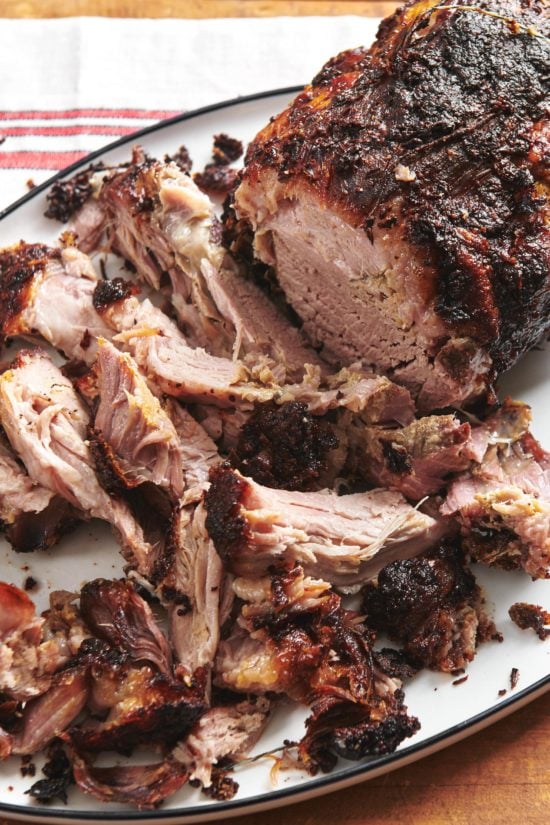Making pulled pork in the oven yields the juiciest, most tender, and best-tasting shredded pork. Without a smoker or grill, this oven-roasted pork shoulder is cooked slowly and makes the ideal BBQ pork for sandwiches, potlucks, and delicious leftovers.
This oven roasted pork shoulder recipe starts cooking at a high temperature to get that deliciously crispy bark, then cooks slowly until the meat melts away from the bone!
I do not include BBQ sauce in this recipe, but be sure to provide a variety for guests to choose from. Get out the pickles and toast some buns for a quick meal that tastes like labor of love!
The best cut of meat for pulled pork, whether you’re making sandwiches or anything else, is a pork shoulder. Boneless pork shoulders or bone-in will work for this recipe.
Because of their high fat content, pork shoulder roasts are perfect for pulling (or shredding). Furthermore, for meat that can be easily shredded, the meat must be cooked slowly and at a low temperature.
Getting Your Pork Roast Ready For Roasting
1) Remove your pork roast from the refrigerator and allow it to sit at room temperature for 30 to 60 minutes. Preheat the oven temperature to 300°F.
2) If the fat on the outside of your pork roast is thick, remove all but a thin layer of it to make it thinner.
Tip: Don’t throw this fat out. It should be lightly salted before being placed in a single layer in a cake pan (preferably one with edges because a lot of hot, fatty liquid will leak out of it). Roast it at 300 degrees Fahrenheit until some fat renders. Drain off the fat and keep roasting until very crispy. Check it every 30 minutes or so. Break it into pieces once it is crisp and lightly browned. Blot it with some paper towels. Try hard not to eat it all yourself.
3) Combine one teaspoon of salt, one and a half teaspoons of pepper, and one and a half teaspoons of garlic powder in a small bowl. That’s the right amount for a 5 lb. roast. Depending on how big or small your roast is, adjust the amounts. Sprinkle the seasoning mixture all over your roast.
Slow-Roasting PorkButt in the Oven
There are two efficient ways to bake a pork butt roast or any other shoulder roast. The obvious first choice is to roast it. According to the USDA’s standard procedure, you should cook the pork at 350°F until it is the desired degree of doneness. That method is effective, but as the pork cooks, you’ll lose a lot of moisture, which could leave the surface areas chewy and dry.
Generally speaking, slow roasting is preferable, especially if you want a well-done roast or pulled pork texture. Set your oven to a temperature between 250 and 300 degrees Fahrenheit, and cook the food slowly until it is cooked to your preference. If you want a rich pot roast or pulled pork texture, allow this to cook for between 1 and 1 1/2 hours per pound. The pork roast can be seared on all sides to brown it before cooking, or it can be browned in a hot oven at 450°F to 500°F for the last few minutes of cooking. Either option works.
For a Larger Pork Shoulder Roast
A longer period of low and slow cooking follows a brief period of high heat roasting for a larger pork roast. Again, you want the meat to be falling apart tender. Since each piece of pork and each oven differs, use the time ranges listed below as a general guide. Start checking at the shorter end of the cooking time, and if you need to let it cook for longer to make the meat tender, that’s okay. Once it starts to become tender, check it every 30 minutes until it is completely mushy and crumbling.
You should incorporate an additional half of the marinade ingredients for any roast heavier than a 6 pound roast. You should double the marinade if you have a roast that weighs 10 pounds or more.
- 7 pound pork roast: Start with the heat at 450° for 20 minutes, then turn the heat down to 250°F and continue to cook for 7 to 8 1/2 hours until the middle of the roast registers 180°F.
- 8 pound pork roast: Start with the heat at 450° for 20 minutes, then turn the heat down to 250°F and continue to cook for 7 1/2 to 8 1/2 hours until the middle of the roast registers 180°F.
- 9 pound pork roast: Start with the heat at 450° for 20 minutes, then turn the heat down to 250°F and continue to cook for 8 to 10 hours until the middle of the roast registers 180°F.
- 10 pound pork roast: Start with the heat at 450° for 20 minutes, then turn the heat down to 250°F and continue to cook for 8 1/2 to 10 1/2 hours until the middle of the roast registers 180°F.
The use of anchovies in the marinade is highly recommended; they don’t add a strong fishy flavor, but rather a depth of flavor that, I guarantee, won’t taste like anchovies. You can substitute 2 teaspoons of fish sauce, 3 teaspoons of minced capers, or even 2 teaspoons of soy sauce if you don’t have them or don’t want to use them.

